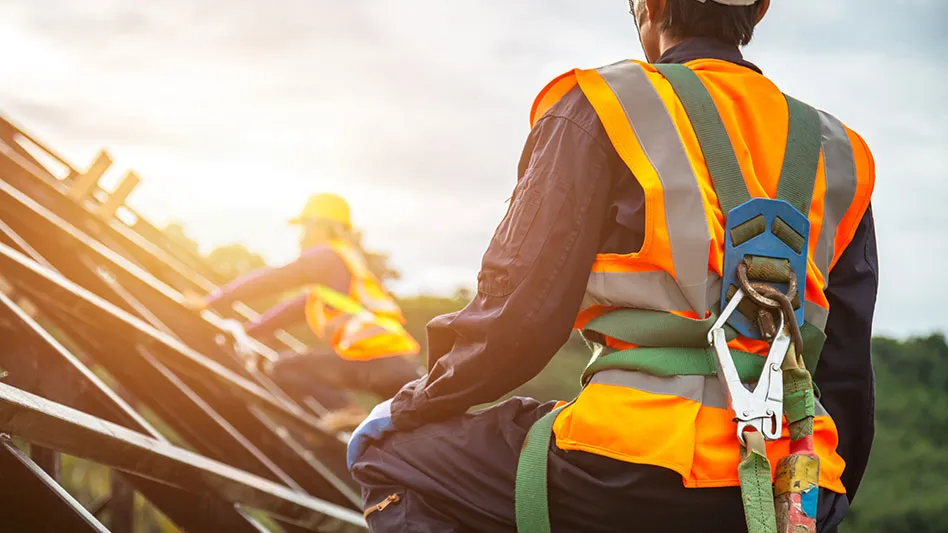
© tong2530 | stock.adobe.com
Research findings by Dodge Construction Network (DCN) and the Center for Protection of Workers’ Rights (CPWR), a nonprofit focused on reducing occupational injuries, illnesses and fatalities in construction, reveal an increase in the implementation of safety and health strategies but highlight a need for greater adoption across the industry.
The study, "Safety Management in the Construction Industry 2023 SmartMarket Report," examines occupational safety and health challenges across the industry and shines a light on where more effort is needed.
Heat
Working in extreme heat is increasingly common in construction, posing significant safety and health risks to workers. To combat this problem, researchers noted 52 percent of contractors in the study report making changes at their company in the last three years to prevent heat-related illnesses on site and 66 percent of contractors implemented a heat-safety policy at their company.
The most common practices to address heat-related issues are providing water, rest, shade and worker training. Less common practices are monitoring the environment for heat hazards and administrative controls such as pausing work in the hottest parts of the day.
While the data indicate progress, researchers say there are large disparities by company size. Only 21 percent of employers with fewer than 20 employees made changes to address heat in the last three years while another 21 percent of the small contractors do not consider heat stress an issue at all.
“Employers need to provide workplaces that control recognized hazards, including heat,” CPWR Executive Director Chris Trahan says. “Many firms are showing that protecting their workers from excessive heat is good for safety and good for business, but this report shows many still are not.”
Mental health, suicide and opioid use
When asked about topics in which they want additional training and information, such as webinars, factsheets, infographics and toolbox talks, the study revealed a high level of interest on worker wellbeing. Fifty-two percent of contractors wanted more resources for managing mental health, suicide and opioid use.
The next most frequently cited topic was lifting or ergonomics and safety at 34 percent. This is a striking finding, according to researchers, considering the rest of the list consists of well-known hazards that still plague the industry.
RELATED: ABC partners with AFSP to address mental health in the construction industry
Contractors were asked whether their company provides a program for substance use or mental health, such as access to professional services. There were major differences depending on company size, as 80 percent of large contractors (100 or more employees) offer programs for substance use or mental health while only 29 percent of small companies (fewer than 20 employees) offer these programs.
Strategies like having a peer network to address substance use or mental health are relatively uncommon, but more frequent among large contractors and those that employ union craftworkers.
Preproject and pretask engagement
The study also examines the use and subsequent advantages of other safety practices on the job site, including during preconstruction and pretask planning. Both strategies show the clear benefits of engaging multiple viewpoints in these processes:
- Ninety-four percent of contractors who engaged in most (seven or more) of these activities reported an increase in worker engagement with safety measures.
- Eighty-four percent of those contractors reported a reduction in recordable injury rates.
- Sixty percent of those contractors saw an improvement in productivity.
The study also examined other good safety practices, including the use of right-sized PPE, online training and the use of technology. It found that one of the biggest opportunities for contractors to improve safety is to use data gathered on their projects more effectively. Nearly a quarter of the contractors who collect project safety data said they do not analyze it.
Implementation across companies
The study also dives into the effective implementation of safety practices among firms of different sizes, as well as ways to improve. For example, the study highlights safety measures that smaller firms could use that larger firms have already adopted. These methods include getting workers more engaged in pretask planning and using free online tools to promote worker well-being.
“Many small companies don’t have dedicated safety managers like you would see at a larger company, so data like this is particularly valuable to help provide education about how the industry is improving worker safety, health and well-being,” says Donna Laquidara-Carr, industry insights research director at Dodge Construction Network.
Since 2012, DCN and CPWR have partnered to deliver studies on construction safety management. Previous reports examined commonly used safety practices and the corresponding benefits contractors experience from investments in safety. The full report can be downloaded here.
Latest from Construction & Demolition Recycling
- Connect Work Tools names new service manager
- Architects’ billings slow, contractors stay busy into summer
- RMDAS figures show ferrous still in a trough
- Mt. Diablo receives RCI certification at Pittsburg, California, C&D facility
- Plastics recycling company wins top prize at NextCycle Colorado Pitch Competition
- Arena-sized venue is demolition target in Alabama
- Brandt scrap handlers available through Murphy Tractor
- Hendrickson celebrates Tiremaax installation milestone





